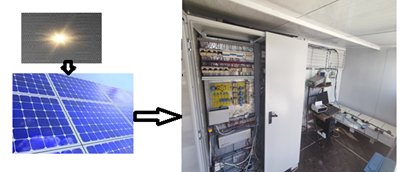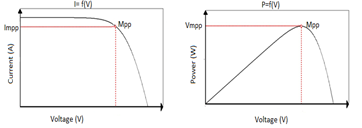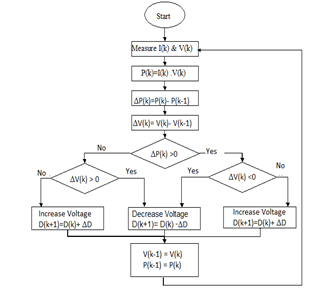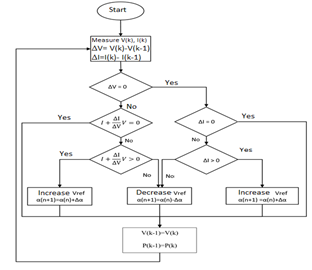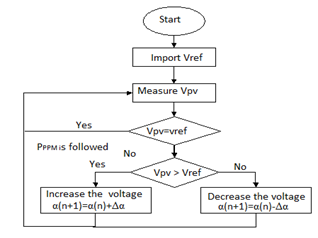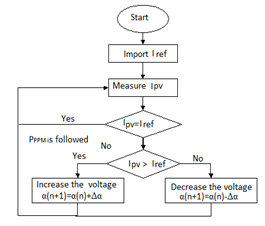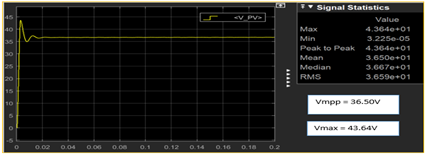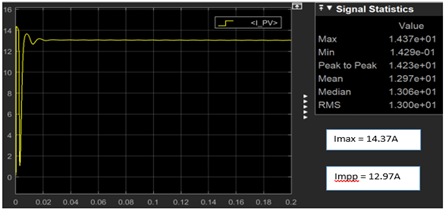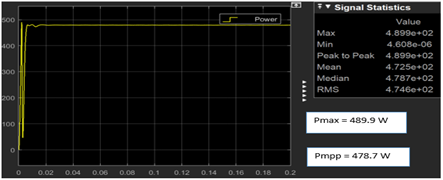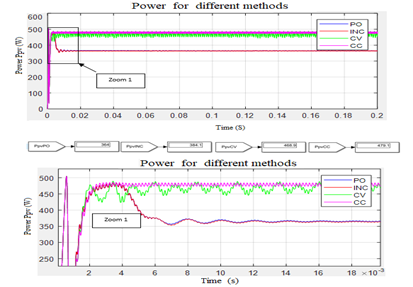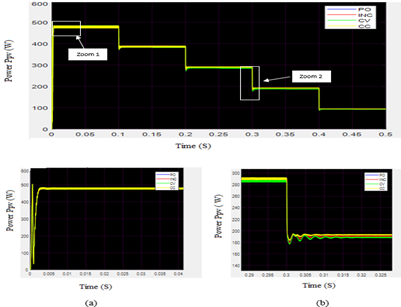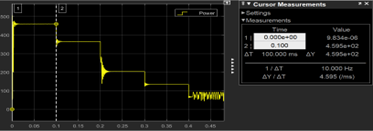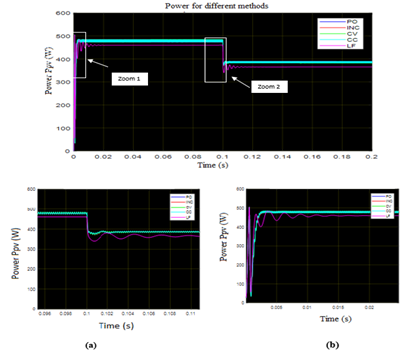Review Article
The Exploration of Maximum Power Point PPM Tracking Algorithms for Photovoltaic Systems: Comparative Analysis
1Houari-Boumediene University of Science and Technology, BP 32, El Alia, Bab Ezzouar, Algiers, Algeria.
2Renewable Energy Development Center, BP. 62 Route de l'Observatoire Bouzareah 16340, Algiers, Algeria.
*Corresponding Author: Saheb Djohra, Houari-Boumediene University of Science and Technology, BP 32, El Alia, Bab Ezzouar, Algiers, Algeria.
Citation: Bossoah G.E., Djohra S., Malika L. (2025). The Exploration of Maximum Power Point PPM Tracking Algorithms for Photovoltaic Systems: Comparative Analysis. Scientific Research and Reports. BioRes Scientia Publishers. 3(1):1-9. DOI: 10.59657/2996-8550.brs.25.039
Copyright: © 2025 Saheb Djohra, this is an open-access article distributed under the terms of the Creative Commons Attribution License, which permits unrestricted use, distribution, and reproduction in any medium, provided the original author and source are credited.
Received: December 24, 2024 | Accepted: January 07, 2025 | Published: January 14, 2025
Abstract
This paper offers an in-depth exploration of MPPT techniques and their importance in maximizing power efficiency. It begins with a discussion on fundamental PV principles, including the I-V characteristic curve and the concept of the maximum power point (MPP). It then addresses challenges associated with fixed-load coupling, emphasizing the inefficiencies that arise when the operating point deviates from the MPP. Various MPPT algorithms and strategies are examined, encompassing Perturb and Observe (P&O), Incremental Conductance (IncCond), and model-based techniques. Implementation aspects and practical considerations are also discussed. Additionally, the paper explores Pursuit of Maximum Power Point (PPPM) concepts, extending MPPT to account for dynamic environmental changes and load demands. This comprehensive guide aims to assist researchers, engineers, and practitioners in maximizing power efficiency in PV systems, contributing to sustainable and cost-effective solar power generation.
Keywords: MPPT techniques; power efficiency; photovoltaic systems; implementation; sustainable energy
Introduction
The increasing demand for renewable energy sources has led to significant advancements in photovoltaic (PV) systems, which harness solar energy to generate electricity (Shaikh, 2017) (Hayat, 2019)(Demirbas, 2007) (Keskar Vinaya, 2013) & (Kumar C. M., 2023). However, the efficiency of PV systems is heavily dependent on various factors such as environmental conditions, system configuration, and most importantly, the ability to track and utilize the maximum power available from the solar panels. In this context, Maximum Power Point Tracking (MPPT) techniques play a crucial role in optimizing the performance and efficiency of PV systems (Nadeem, 2023).
Amidst the literature, there are comprehensive studies on novel MPPT algorithms, comparative analyses of distinct maximum power point tracking techniques, evaluations of real-world performance, and critical reflections on emerging challenges and opportunities in this dynamic domain (Cheikh, 2007), (Benkhelil, 2011), (Mokhlis, 2020), (Daoud, 2010), (Abbes, 2014) and (Yu, 2004).
In this context, the present paper aims to provide an in-depth exploration of MPPT techniques and their significance in maximizing power efficiency in PV systems (Ahmed, 2015) (Kumar M. e., (2023)) & (Sharma, 2023). We begin by discussing the fundamental principles of PV operation, including the I-V characteristic curve and the concept of the maximum power point (MPP) . Subsequently, we delve into the challenges associated with fixed-load coupling in PV systems, highlighting the inherent inefficiencies that arise when the operating point deviates from the MPP.
Furthermore, this paper examines various MPPT algorithms and strategies that have been developed to overcome these challenges and ensure that PV systems operate at their maximum power output under different operating conditions. We explore both conventional and advanced MPPT methods, including Perturb and Observe (P&O), Incremental Conductance (IncCond), and model-based techniques, among others. Moreover, we discuss the implementation aspects and practical considerations associated with these MPPT techniques in real-world PV installations.
In addition to discussing MPPT techniques, this paper also addresses the concept of Pursuit of Maximum Power Point (PPPM), which extends the traditional MPPT framework to account for dynamic changes in environmental conditions and load demands. We examine how PPPM strategies enhance the adaptability and robustness of PV systems, particularly in scenarios with partial shading, temperature variations, and non-linear loads.
Overall, this paper serves as a comprehensive guide for researchers, engineers, and practitioners in the field of solar energy, offering valuable insights into the latest developments and best practices for maximizing power efficiency in photovoltaic systems through effective MPPT techniques. Through a thorough analysis of MPPT algorithms and their implementation, this paper aims to contribute to the ongoing efforts towards achieving sustainable and cost-effective solar power generation.
Experimental system
The present research focuses on analyzing a photovoltaic autonomous system with battery storage, as depicted in Figure 1. This system is meticulously engineered to harness clean energy sources efficiently. Leveraging solar photovoltaic energy, it charges storage batteries to power the lighting infrastructure at the CDER (Centre for Renewable Energy Research and Development) in Bouzareah, Algiers. A critical aspect of this system is to mitigate excessive depth of discharge (DOD), which can potentially reach up to -5%.
Figure 1: Experimental PV system/batteries installed at CDER
The MPPT/PPM command
The MPPT/PPM command function operates a PV system to continuously produce its maximum power output. Thus, regardless of meteorological conditions (temperature and irradiance), the converter control positions the system at the maximum power point (Vmpp, Impp) as shown in Fig. 2 (AAMAROUAYACHE, 2014). The MPPT command is crucial for the optimal operation of the PV system. The principle of this command is based on the automatic variation of the duty cycle α in response to changes in the input parameters (I, V, and the power P of the PV panel) until it reaches the optimal value to maximize the power delivered by the PV panel.
Figure 2: The optimal operating point Vmpp and Impp (BENADEL, 2016).
The PPM tracking algorithms
Many algorithms for PPM have been proposed by researchers. Various tracking methods and strategies exist and are used in the literature. We propose to study the following different control algorithms:
Perturb and Observe Algorithm (P&O)
The Perturb and Observe (P&O) Maximum Power Point Tracking (MPPT) algorithm is a commonly used method in photovoltaic (PV) systems to optimize the power output of solar panels. It works by continuously adjusting the operating point of the PV system to ensure that it operates at its maximum power point (MPP), where the power output is maximized. This method is widely used today because it yields good results and is easy to implement. This algorithm is summarized in the flowchart of the followed figure.
Figure 3: Flowchart of the Perturb and Observe Algorithm (BENADEL, 2016).
The Conductance Incremental (INC) algorithm
The Conductance Incremental (INC) algorithm is a community detection algorithm designed to identify communities within a network or graph. The overview of how the INC algorithm works is sumarized in the following flowchart.
Figure 4: Flowchart of the Conductance Incremental (INC) Algorithm (BENADEL, 2016)
Constant Voltage measurement (CA) Algorithm
This algorithm provides a framework for implementing MPPT with Constant Voltage (CV) measurement in solar power systems. Depending on the specific requirements and constraints of the system, additional optimizations and considerations may be necessary. This algorithm is summarized in the flowchart of the followed figure.
Figure 5: Flowchart of the CA Algorithm (BENADEL, 2016)
Algorithm based on Constant Current (CC) measurement
This algorithm provides a basic framework for implementing MPPT with Constant Current (CC) measurement in photovoltaic systems. Depending on specific requirements and constraints, additional optimizations and advanced control techniques may be necessary based on the following flowchart.
Figure 6: Flowchart of the CC Algorithm (BENADEL, 2016)
Algorithm based on Fuzzy Logic (FL)
Fuzzy logic can be applied to MPPT algorithms to achieve efficient tracking, especially under varying environmental conditions. Here's a basic algorithm outline for an MPPT using fuzzy logic:
Figure 7.
Figure 7: Principal fuzzy logic control
Simulations and Comparisons of Methods
Parameters, simulation results and discussions
It is important to know that the parameter choices used for our simulations were based on the acquisition models used at the experimental site of the CDER in Bouzareah, Algiers (see Fig.1).
The PV Generator: A field of PV panels connected with three modules in parallel and two modules in series. The following Table 1 provides its characteristics:
Table 1: PV Generator Parameters
| Module PV | Champ PVs | ||
| Parametrs | Values | Parametrs | Values |
| Pmpp (W) | 80.10 | Pmpp (W) | 480.6 |
| Vmpp (V) | 18.00 | Vmpp (V) | 36 |
| Impp (A) | 4.45 | Impp (A) | 13.35 |
| Voc (V) | 22.00 | Voc (V) | 44.00 |
| Icc (A) | 4.80 | Icc (A) | 14.40 |
The characteristics of the PV arrays under standard test conditions are shown in the figures below:
Figure 8: Optimal PV Voltage - Vpv = f(t)
Figure 9: Optimal PV Current - Ipv = f(t)
Figure 10: Optimal PV Power - Ppv = f(t)
It is observed that the values obtained in the simulations correspond to the parameters established in Table 1.
Optimization of Energy Transferred to Receivers
To validate the various algorithms studied previously and to verify the effect of the perturbation step on the different algorithms, our controller was tested under different scenarios. In Figure 11, we present the test conducted on our controller under standard conditions with a large perturbation step (dD=1e-04).
Figure 11: Output power variation under constant irradiation at 1000W/m², constant temperature at 25°C, and dD=1e-04: a) Zoom 1
The P&O and INC algorithms are known as classical techniques, while the CV and CC algorithms are known as real-time measurement techniques. It is observed that when the perturbation step size is large (dD=1e-04) (see Fig. 11), the CV and CC algorithms exhibit significant oscillations and overshoot, failing to stabilize. The P&O and INC algorithms also exhibit significant oscillations and take longer to stabilize. Furthermore, there is a considerable loss of power during the stabilization process, which persists even under stable conditions.
Figure 12 depicts the testing of our controller across varying irradiation levels, maintaining a constant temperature with minimal disturbance (dD=1e-07).
Figure 12: The output power with a step size of dD=1e-07 under varying irradiation levels [1000, 800, 600, 400, 200] W/m² while maintaining a constant temperature of 25°C. The results are presented in two zoomed-in views: Zoom 1 and Zoom 2.
Based on the experiment conducted regarding the variation of irradiation applied to our system, it is evident that when the step size is small (dD=1e-07) as depicted in Fig. 12, the PPM algorithms exhibit minimal oscillations, negligible overshoots, and rapid stabilization. This leads to reduced power losses under stable or slowly changing conditions. (Bassoah, 2022).
The results obtained (Figure 12) demonstrate the effectiveness of our algorithms in MPPT with a small step size, as the values obtained closely align with the PPM. Therefore, we decide to adopt the small step size as our preferred choice, as comparisons under standard conditions indicate that it yields the best results.
Following simulation with a small step size, the P&O algorithm yielded a PPM of 479.3W under standard conditions (between 0 and 0.1s) out of a field of 480.6W. This traditional method is effective and widely employed. However, its primary drawback is that the operating point oscillates around the PPM, even during sunny days when irradiance changes slowly, resulting in the wastage of available energy and a sluggish response rate.
After simulation with a small step size, the P&O algorithm yielded a PPM of 479.3W under standard conditions (between 0 and 0.1s) out of a field of 480.6W. This classic method is effective and commonly used. However, its major drawback is that the operating point oscillates around the PPM, even on sunny days when irradiance changes slowly. This results in the wastage of some available energy and a slow response speed.
Similarly, simulation of the CV algorithm with a small step size resulted in a PPM of 479.2W under standard conditions (between 0 and 0.1s) out of a field of 480.6W. This measurement method is also effective as it produces good results and is typically favored due to the relative ease of voltage measurement and the simplicity of system open-circuiting. However, its drawback lies in its lower efficiency in tracking the PPM compared to other methods. This is due to the poor choice of the Kv value and the fact that voltage measurement at open circuit requires a momentary interruption of the PV power supply.
Following simulation with a small step size, the CC algorithm provided a PPM of 478.5W under standard conditions (between 0 and 0.1s) out of a field of 480.6W. This measurement method is also effective as it yields good results. However, its drawbacks include its lower efficiency in tracking the PPM compared to other methods. This is attributed to the chosen value of Kc and the fact that measuring short-circuit current is not as straightforward as voltage measurement. It is practically impossible to short-circuit the system continuously for current measurement.
The LF algorithm is recognized as an intelligent technique and one of the various algorithms studied in our project. To validate this method, we tested our controller under various irradiance levels (Figure 13).
The test conducted on the LF algorithm under standard conditions (between 0 and 0.1s) yields a PPM of 459.5W on a field of 480.6W. This intelligent method proves to be ineffective in our case, as it does not lead to improved performance. We observe significant oscillations before stabilization, with a long response time. The results obtained with this control approach are not superior to those of other studied methods. Nevertheless, it has an advantage as a robust method generally effective in boost converters.
Comparative Study Among the Investigated Control Methods
For a better assessment regarding the best control method among the studied algorithms, a comparative study was conducted (Table 2), yielding the following simulation results: Figure 14 illustrates the output power characteristics for a constant temperature of 25°C and variable irradiations [1000 800] W/m².
Figure 13: Power Variation under different irradiation conditions [1000 800 600 400 200] W/m² at T=25°C.
Table 2:Comparison Among Studied MPPT Control Methods
| Algorithm | P&O | INC | CV | CC | LF |
| Convergence Speed | Fast | Fast | Fast | Fast | Very Fast |
| Oscillations | Small | Small | Small | Small | Large |
| Accuracy | 95% | 95% | 95% | 95% | 91% |
| Complexity | Low | High | Very low | Low | Very high |
| Response Time | Fast | Fast | Fast | Fast | Very Fast |
Figure 14 demonstrates that our PV system converges towards optimal values, enabling us to select the best method for our system. After comparative performance studies of the methods shown in Table 2, it is evident that all methods except LF exhibit almost identical characteristics. Therefore, the INC algorithm is the best choice for our buck converter as it yields the highest power compared to others.
Figure 14: The output power characteristics for a constant temperature of 25°C and variable irradiations [1000 800] W/m².
Conclusion
There are several principles of operation for MPPT controls, varying in performance based on PV system properties. In this paper, we have studied the operation to control energy flow transferred within a photovoltaic system from the PV generator to the loads. A synthesis of the main PPM tracking modes after various tests on the influence of different irradiations, disturbance step sizes, and comparisons among different existing controls has allowed us to identify the type of control that will be most efficient and suitable for our system.
References
- Aamarouayache, M. (2014). Contribution à l’optimisation d’une chaine de conversion d’énergie photovoltaïque. Doctoral dissertation, Université des Sciences et de la Technologie Houari Boumediene.
Publisher | Google Scholor - Abbes, H. A. (2014). Etude comparative de cinq algorithmes de commande MPPT pour un système photovoltaïque. Journal of Renewable Energies, 17(3):435-445.
Publisher | Google Scholor - Ahmed, J., & Salam, Z. (2015). A critical evaluation on maximum power point tracking methods for partial shading in PV systems. Renewable and Sustainable Energy Reviews, 47:933-953.
Publisher | Google Scholor - Bassoah, G. E. (2022). Etude et conception d’un système photovoltaïque. Master’s thesis. Université des Sciences et de la Technologie Houari Boumediene.
Publisher | Google Scholor - Benadel, F. (2016). Etude et simulation d’une commande MPPT pour système PV [Master’s thesis. Université Mohamed Boudiaf de M’Sila.
Publisher | Google Scholor - Benkhelil, E., & Cheikh, M. S. (2011). Modélisation et simulation d’un générateur photovoltaïque avec un étage d’adaptation DC/DC. Revue des Energies Renouvelables ICESD’11 Adrar, 159-170.
Publisher | Google Scholor - Cheikh, M. S. (2007). Maximum power point tracking using a fuzzy logic control scheme. Journal of Renewable Energies, 387-395.
Publisher | Google Scholor - Daoud, A., & Chenni, R. (2010). Maximum power point tracking techniques for solar water pumping systems. Revue des Energies Renouvelables, 13(3):497-507.
Publisher | Google Scholor - Demirbas, M. F. (2007). Electricity production using solar energy. Energy Sources, 29(6):563-569.
Publisher | Google Scholor - Hayat, M. B. (2019). Solar energy—A look into power generation, challenges, and a solar-powered future. International Journal of Energy Research, 43(3):1049-1067.
Publisher | Google Scholor - Keskar Vinaya, N. (2013). Electricity generation using solar power. International Journal of Engineering Research & Technology (IJERT), 2(2):1-5.
Publisher | Google Scholor - Kumar, C. M. (2023). Solar energy: A promising renewable source for meeting energy demand in Indian agriculture applications. Sustainable Energy Technologies and Assessments, 55:102905.
Publisher | Google Scholor - Kumar, M., & Singh, R. (2023). Comprehensive review of conventional and emerging maximum power point tracking algorithms for uniformly and partially shaded solar photovoltaic systems. IEEE Access.
Publisher | Google Scholor - Mokhlis, M. F., & Elgendy, M. A. (2020). Comparative study between the different MPPT techniques. 5th International Conference on Renewable Energies for Developing Countries (REDEC), 1-6.
Publisher | Google Scholor - Nadeem, A., & Hussain, S. (2023). A comprehensive review of global maximum power point tracking algorithms for photovoltaic systems. Energy Systems, 14(2):293-334.
Publisher | Google Scholor - Shaikh, M. R. (2017). Review paper on electricity generation from solar energy.
Publisher | Google Scholor - Sharma, A. K. (2023). Role of metaheuristic approaches for implementation of integrated MPPT-PV systems: A comprehensive study. Mathematics, 11(2):269.
Publisher | Google Scholor - Yu, G. J., & Chae, K. S. (2004). A novel two-mode MPPT control algorithm based on comparative study of existing algorithms. Solar Energy, 76(4):455-463.
Publisher | Google Scholor

